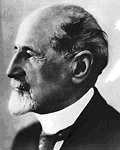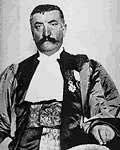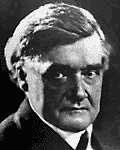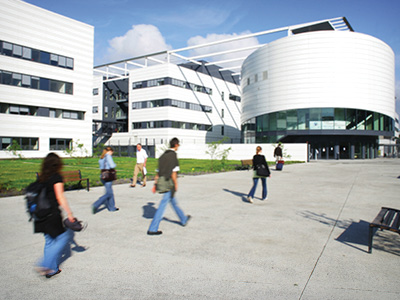
These missions are carried out within a public institution with a scientific, cultural, and professional focus, initially (from 1971 to 2007) with a status similar to that of universities, and then, by decree of March 8, 2007, with the status of a "grand établissement."
The history of Grenoble INP - UGA demonstrates how our institution has worked closely with industry since its inception. The origins of the Polytechnic Institute are strongly linked to the beginnings of hydroelectric power.
Origins of the Polytechnic Institute



Paul Janet, Joseph Pionchon and Louis Barbillion
In 1892, a young lecturer, Paul Janet, launched the first course in industrial electricity in Grenoble. This course was so successful that, due to pressure from local dignitaries and industrialists, the Faculty of Sciences decided to make it a permanent offering.
In 1898, during a historic session of the University Council, the creation of an Institute of Electrotechnics was approved. Affiliated with the Faculty of Sciences, this institute, the precursor of the National School of Electrical Engineering, welcomed its first class in 1900. The following years were shaped by the work of Louis Barbillion, appointed director in 1904, who dreamed of establishing a full-fledged technical university in southeastern France by adding new specialties to electrotechnics.
In 1907, the Union of Paper and Cardboard Manufacturers established the French School of Papermaking (EFP), annexed to the Institute of Electrotechnics. Around the same time, hydraulics, mechanics, electrochemistry, and electrometallurgy began to develop. This growing institution, which included comprehensive engineering programs, specialized years, laboratories, and various applied sciences courses, became known as the Polytechnic Institute of Grenoble (IPG).


In the 1920s, industrial demands became more precise, and training programs were expanded, leading to the founding of the Institute of Electrochemistry and Electrometallurgy (IEE) and the School of Hydraulic Engineering (EIH). In 1928, René Gosse succeeded Louis Barbillion as head of the IPG. His managerial skills and extensive network enabled him to advance Grenoble’s scientific growth. Despite the economic crisis of the 1930s, he managed to complete significant expansions of the Institute, opening up new opportunities for growth.
Under the leadership of Félix Esclangon and Louis Néel, the National School of Electronics and Radioelectricity of Grenoble (ENSERG) was founded in 1958, followed by the National School of Computer Science and Applied Mathematics of Grenoble (ENSIMAG) in 1960.
The Grenoble National Polytechnic Institute (INPG), bringing together six schools, was established by decree on December 23, 1970, with Louis Néel, Nobel Prize in Physics, serving as its first president in 1971.

Louis Néel
Three more schools were later established: the National School of Physics (ENSPG) in 1985, the National School of Industrial Engineering (ENSGI) in 1990, and in Valence, the Rhône-Alpes Graduate School of Engineering in Advanced Industrial Systems (ESISAR) in 1995, along with the Telecommunications Department in 1999.Grenoble INP - UGA today

Parvis Louis Néel, Minatec
The Institute has consistently supported - and often anticipated - industrial developments by establishing engineering schools and research laboratories. Grenoble INP - UGA continued its growth into the modern era by embarking on the journey of micro and nanotechnologies. In 2002, it became a founding member, alongside the CEA, of the Minatec innovation hub, inaugurated in June 2006.
The Institute also plays a governance role in two key competitiveness clusters where it is highly active: Minalogic, a global leader in micro and nanotechnologies and embedded software, and Tenerrdis, which focuses on renewable energy.
Grenoble INP - UGA is also deeply involved in the Advanced Research Thematic Network (RTRA) "Nanosciences at the Limits of Nanoelectronics" and leads two Carnot Institutes: "Intelligent Software and Systems" and "Energy of the Future."
The Reform and “Grand Establishment” Status
Following multiple evaluations (notably by the International Visiting Committee), Paul Jacquet (president, then managing director of the Institute from 2002 to 2012) launched a large-scale reform project from 2004 to 2008. This reform encompassed all state-assigned missions: education, research, development, and governance structures.
The "grand établissement" status was granted on March 8, 2007. This status allowed for changes in the Institute's governance, especially regarding the composition of the three councils (Board of Directors, Scientific Council, and Council for Studies and Student Life). It significantly increased the participation of external figures, allowed presidents from the six new schools to sit on the Board of Directors, and made it possible for an industry leader to chair the Board.

Grenoble INP - Pagora, UGA
A Research Directorate was established on January 1, 2008, tasked with leading scientific policy and overseeing all laboratories associated with the institution (which were previously linked to individual schools).
Six new engineering schools were established in the fall of 2008, marking the first time in its history that Grenoble INP redefined the scope of its schools, reduced their number, and created a unified curriculum structure. The Institute became known as Grenoble INP, comprising:
- Grenoble INP - Ense3, UGA (from the merger of ENSHMG and ENSIEG),
- Grenoble INP - Ensimag, UGA (from the merger of ENSIMAG and Télécom),
- Grenoble INP - Esisar, UGA,
- Grenoble INP - Génie industriel, UGA (from the merger of ENSGI and part of ENSHMG),
- Grenoble INP - Pagora, UGA (from the EFPG),
- Grenoble INP - Phelma, UGA (from the merger of ENSEEG, ENSPG, and ENSERG).
In January 2010, Grenoble INP - UGA also obtained Expanded Responsibilities and Competencies (RCE), granting it autonomy to manage its payroll and employment cap—a significant milestone following the major restructuring process.
The institution expanded internationally by establishing several international laboratories and an engineering school in Guangzhou, China. This project, under the leadership of Grenoble INP - UGA, brought together a consortium including the National Institute of Nuclear Science and Technology (INSTN, part of the CEA), the École des Mines de Nantes, the École Nationale Supérieure de Chimie de Montpellier, and the École Nationale Supérieure de Chimie de Paris. The Franco-Chinese Institute of Nuclear Energy (IFCEN) opened its doors on September 1, 2010.
Grenoble INP, Institute of Engineering and Management of the Université Grenoble Alpes
The "Grenoble, University of Innovation" project was selected in the Ministry’s 2008 "Operation Campus" call for proposals, ranking among the 12 chosen across France. Grenoble is now recognized as one of the "12 Major International Campuses of Tomorrow." In July 2009, the Ministry awarded €400 million to support the Grenoble project, enabling the establishment of major thematic centers. Grenoble Université de l'Innovation is a consortium uniting 11 partners involved in scientific development (universities, grandes écoles, and research organizations) and is strongly supported by local authorities. This ambitious project will shape Grenoble’s scientific future for the next 20 years.
The Université Grenoble Alpes Experimental Public Institution (EPE) was established on January 1, 2020. Université Grenoble Alpes, Grenoble INP - UGA, Sciences Po Grenoble, and the École Nationale Supérieure d'Architecture de Grenoble (ENSAG) merged into a single university with strong international influence. Openness and diversity, social and environmental responsibility, dynamism, and innovation are the guiding principles of this shared ambition.

Le bâtiment GreEn-ER (Grenoble INP - Ense3, UGA)


